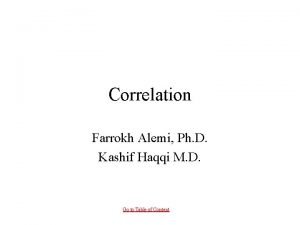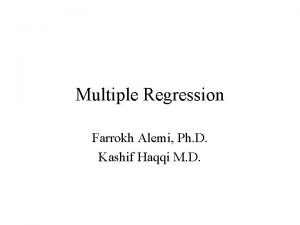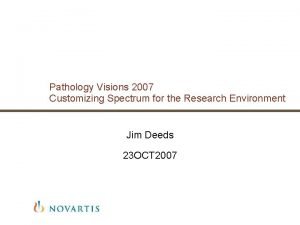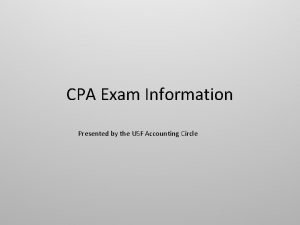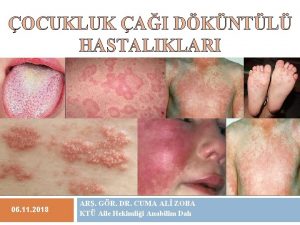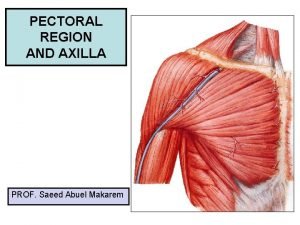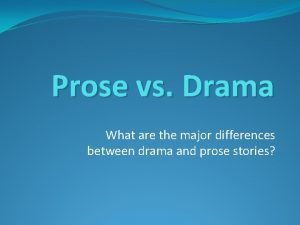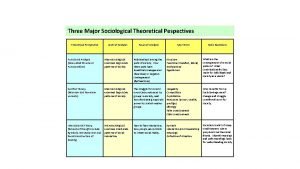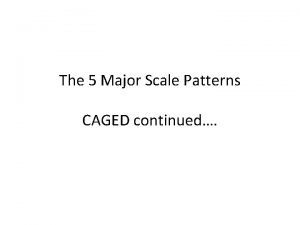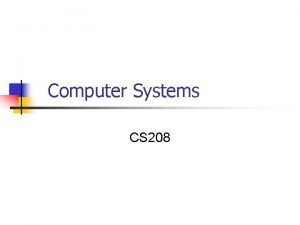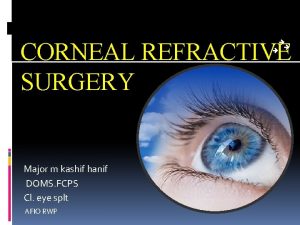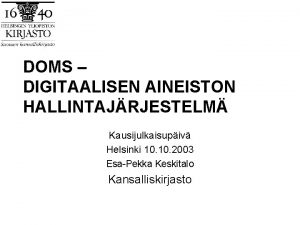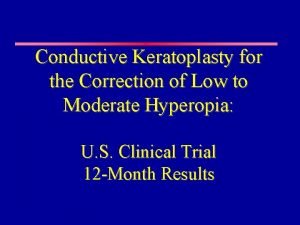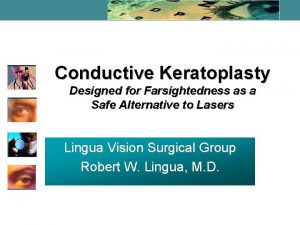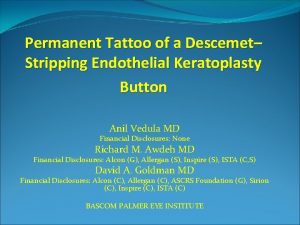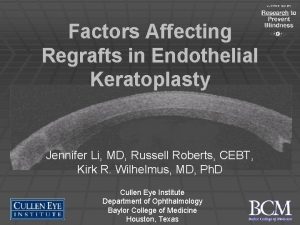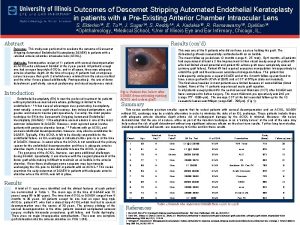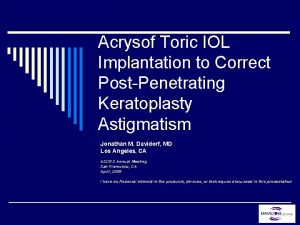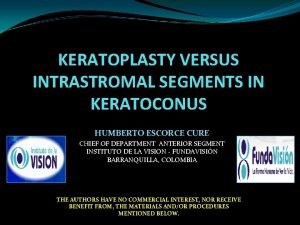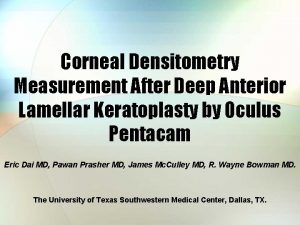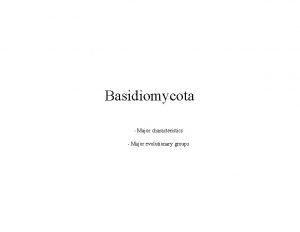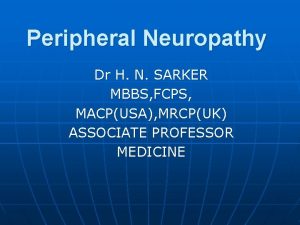KERATOPLASTY Major M Kashif Hanif DOMS FCPS AFIO







































- Slides: 39

KERATOPLASTY Major M Kashif Hanif DOMS FCPS AFIO RWP

• Keratoplasty (corneal transplantation, grafting) is an operation in which abnormal corneal host tissue is replaced by healthy donor cornea • A corneal graft may be (a) full-thickness (penetrating) (b) partial-thickness (lamellar or deep lamellar)

Penetrating keratoplasty • Indications • Optical keratoplasty is performed to improve vision • • Bullous keratopathy Keratoconus Dystrophies & degenerations Scarring • Tectonic grafting may be carried out to restore or preserve corneal integrity in eyes with severe structural changes such as • Stromal thinning • Descemetocele

• Therapeutic corneal transplantation may afford removal of infected corneal tissue in eyes unresponsive to antimicrobial therapy • Cosmetic grafting may rarely be performed to improve the appearance of the eye

Donor tissue • Donor tissue should be removed within 24 hours of death. Corneas from infants are usually not used, being floppy and likely to result in high astigmatism • Corneas from donors over the age of 70 years may also be inappropriate due to low endothelial cell counts • Preoperative evaluation of donor tissue includes slit-lamp examination and specular microscopy

• Donor corneas should not be utilized under the following circumstances • Death of unknown cause • Infectious diseases of the CNS (e. g. Creutzfeld-Jakob disease, systemic sclerosing panencephalitis, progressive multifocal leucoencephalopathy) • Certain systemic infections (e. g. AIDS, viral hepatitis, syphilis, septicaemia) • Leukaemia and lymphoma. • Intrinsic eye disease (e. g. malignancy, active inflammation) or previous intraocular surgery

Prognostic Factors • The following factors may adversely affect the prognosis of a corneal graft and should therefore be addressed prior to surgery • Abnormalities of the eyelids such as blepharitis, ectropion, entropion and trichiasis should be corrected before surgery • Tear film dysfunction • Recurrent or progressive forms of conjunctival inflammation, such as atopic conjunctivitis and ocular cicatricial pemphigoid

• Severe stromal vascularization, absence of corneal sensation, extreme thinning at the proposed host-graft junction and active corneal inflammation • Anterior synechiae • Uncontrolled glaucoma • Uveitis

Technique • Determination of graft size • It is done preoperatively with a variable slit beam and operatively, by trial placement of trephines with different diameters or measurement with a caliper • Grafts of diameter 8. 5 mm or more are prone to postoperative anterior synechiae formation, vascularization and increased intraocular pressure • An ideal size is 7. 5 mm; grafts smaller than this may give rise to high astigmatism

Preparation of donor cornea



Partial thickness trephination


• Excision of donor cornea • It should always precede that of the host. Donor tissue is prepared by trephining a previously excised corneoscleral button, endothelial side up in a concave Teflon block • Alternatively, the donor may be trephined from the intact donor globe having first injected air or viscoelastic substance into the anterior chamber • The donor button is usually about 0. 25 mm larger in diameter than the planned diameter of the host opening, to facilitate watertight closure, minimize postoperative flattening and reduce the possibility of postoperative glaucoma


• Excision of diseased host tissue is then carried out taking care not to damage the iris and lens • Sutures are placed through the insertions of the superior and inferior rectus muscles. • Partial-thickness trephination is performed • The anterior chamber is entered with a knife • Excision is completed with scissors • Viscoelastic is injected

• Fixation of donor button is usually with 10 -0 monofilament nylon • The donor button is placed onto the cornea • Four interrupted radial 'cardinal' sutures are placed; the first at 12 o'clock , the second at 6 o'clock, the third at 3 o'clock and the last at 9 o'clock ( The corneal 'bite' should be almost full-thickness to prevent wound gape • Further interrupted sutures are inserted • Closure is completed with a continuous running suture • Replacement of viscoelastic substance with balanced salt solution


Postoperative management • Topical steroids • They are used to reduce immunological graft rejection • After initial administration 2 -hourly and then q. i. d. for a few weeks, the dose may be further tapered, depending on the condition of the eye • Steroids are usually continued at low doses such as once daily for a year or more • Mydriatics b. d. for 2 weeks, or longer if uveitis persists.

• Oral aciclovir may be used in the context of pre-existing herpes simplex keratitis to minimize the risk of recurrence • Removal of sutures when the graft-host junction has healed is usually after 12 -18 months, although in elderly patients it may take much longer • Rigid contact lenses may be required to optimize visual acuity in eyes with astigmatism

Postoperative Complications • Early complications include persistent epithelial defects, irritation by protruding sutures which may give rise to papillary hypertrophy, wound leak, flat anterior chamber, iris prolapse, uveitis, elevation of intraocular pressure and infection. A rare complication is a fixed dilated pupil (Urrets. Zavalia syndrome) • Late complications include astigmatism, recurrence of initial disease process on the graft, late wound separation, retrocorneal membrane formation, glaucoma and cystoid macular oedema

Corneal Allograft Rejection • Allograft rejection of any layer of the cornea can occur following penetrating keratoplasty and, less commonly, lamellar grafts. Endothelial rejection is the most common and most severe as it can lead to severe endothelial cell loss and decompensation. Late graft failure through decompensation can also occur in the absence of further rejection episodes • Stromal rejection and epithelial rejection are less frequent and respond readily to topical steroid treatment with few long-term consequences. Elements of the different types of rejection can coexist

Pathogenesis • The cornea is immunologically privileged and a normal cornea will usually not reject. However, if there is inflammation this privilege is lost and rejection may occur • Other important predisposition for rejection includes corneal vascularization, grafts over 8 mm in diameter, eccentric grafts, infection, glaucoma and previous keratoplasty

• If the host becomes sensitized to the major or minor histocompatibility antigens present in the donor, cornea type IV hypersensitivity can develop against the graft and rejection and graft failure may result • Antigen presenting cells in the donor cornea may initiate this process. HLA Class I matching has a small beneficial effect on graft survival

Symptoms of graft rejection • These include • blurred vision • Photophobia • dull periocular ache • However, many cases are asymptomatic until advanced rejection is established

• Ciliary injection and anterior uveitis is a pre-rejection manifestation • Epithelial rejection may be accompanied by an elevated line of abnormal epithelium

• Stromal rejection is characterized by subepithelial infiltrates, reminiscent of adenoviral infection (Krachmer spots) on the donor cornea • Endothelial rejection is characterized by linear pattern of keratic precipitates (Khodadoust endothelial rejection line) associated with an area of inflammation at the graft margin • Stromal oedema is indicative of endothelial failure

Management • Early treatment is essential as this greatly improves the chances of reversing the rejection episode • Topical steroids (dexamethasone phosphate 0. 1% or prednisolone acetate 1%) hourly for 24 hours are the mainstay of therapy. The frequency is reduced gradually over several weeks but high risk patients should be maintained on the highest tolerated topical dose (e. g. prednisolone acetate 1% q. i. d)

• Systemic steroids (oral prednisolone 1 mg/kg/day in divided doses, or a single intravenous dose of methylprednisolone 500 mg) may help to reverse rejection and prevent further rejection episodes but only if given within 8 days of onset of rejection. Repeated intravenous methylprednisolone may be associated with loss of bone density and osteoporosis • Subconjunctival steroids (betamethasone 2 mg) may be useful

• Differential Diagnosis • • Graft failure Reactivation of HSV Uveitis Epithelial down-growth

Lamellar keratoplasty • Lamellar keratoplasty involves partial thickness excision of the corneal epithelium and stroma so that the endothelium and part of deep stroma are left behind

Indications • Opacification of the superficial one-third of the corneal stroma not caused by potentially recurrent disease • Marginal corneal thinning or infiltration as in recurrent pterygium, Terrien marginal degeneration and limbal dermoids or other tumours • Localized thinning or descemetocele formation

Technique • This is similar to penetrating keratoplasty except that only a partial thickness of cornea is grafted

Deep lamellar keratoplasty • Deep lamellar keratoplasty is a relatively new technique in which all opaque corneal tissue is removed almost to the level of Descemet membrane • The theoretical advantage is the decreased risk of rejection because the endothelium, a major target for rejection, is not transplanted

Indications • Disease involving the anterior 95% of corneal thickness with a normal endothelium and absence of breaks or scars in Descemet membrane • Chronic inflammatory disease such as atopic keratoconjunctivitis which carries an increased risk of graft rejection

Advantages • No risk of endothelial rejection although epithelial rejection may occur • Less astigmatism and a structurally stronger globe as compared with penetrating keratoplasty • Increased availability of graft material since endothelial quality is irrelevant

Disadvantages • Difficult and time-consuming with a high risk of perforation in older patients • Interface haze may limit best final visual acuity

Postoperative management • This is similar to penetrating keratoplasty except that topical steroids are used less frequently and sutures can usually be removed after 6 months
 Mushroom keratoplasty
Mushroom keratoplasty Mbbs doms
Mbbs doms Dom
Dom Kashif haqqi
Kashif haqqi Minus desk in community medicine
Minus desk in community medicine Fatima kashif
Fatima kashif Kashif haqqi
Kashif haqqi Kashif ghani
Kashif ghani Barrel chest
Barrel chest Perusahaan tas hanif membuat 2 macam tas
Perusahaan tas hanif membuat 2 macam tas Hanif khalak
Hanif khalak Hanif nur widhiyanti
Hanif nur widhiyanti Hanif nur widhiyanti
Hanif nur widhiyanti Fairfax county public schools lunch menu
Fairfax county public schools lunch menu 1111 centre parkway lexington ky
1111 centre parkway lexington ky Fcps md
Fcps md Is ielts required for mrcp exam
Is ielts required for mrcp exam Fcps my plt
Fcps my plt Barrel chest
Barrel chest Centreville high school sports
Centreville high school sports Pals rubric level 1 speaking
Pals rubric level 1 speaking Barrel chest
Barrel chest Pog
Pog Standard form syllogism
Standard form syllogism Cpa exam noteboards
Cpa exam noteboards Icmp major
Icmp major Atopik dermatit major kriterler
Atopik dermatit major kriterler Axillary
Axillary Northern ireland lakes
Northern ireland lakes The difference between drama and prose
The difference between drama and prose Approaches to corporate governance
Approaches to corporate governance Three theoretical perspectives in sociology
Three theoretical perspectives in sociology The major activity in strategic planning is
The major activity in strategic planning is Circulatory system interactions with other systems
Circulatory system interactions with other systems Basic education sector reform agenda (besra)
Basic education sector reform agenda (besra) The major reason for chemical bonding is
The major reason for chemical bonding is Stress breakers in removable partial denture pdf
Stress breakers in removable partial denture pdf Caged pattern
Caged pattern Major parts of computer
Major parts of computer Psoas major synergist
Psoas major synergist



